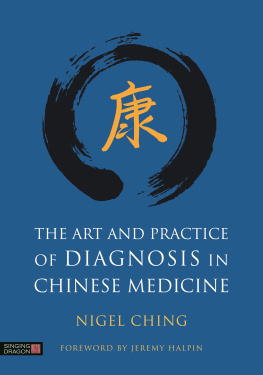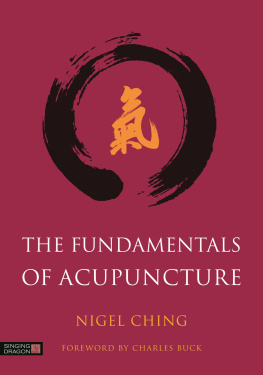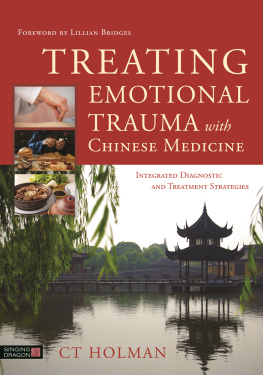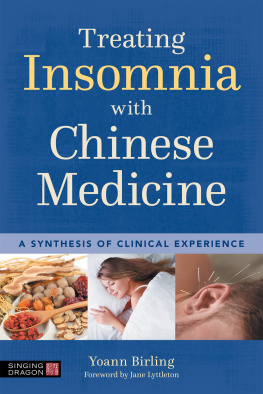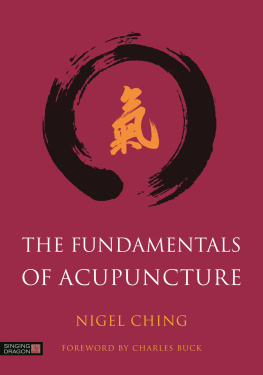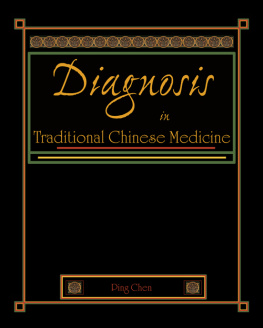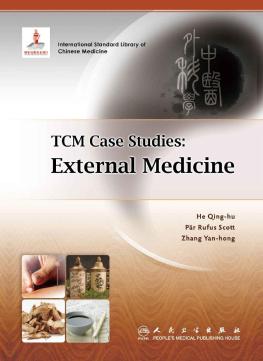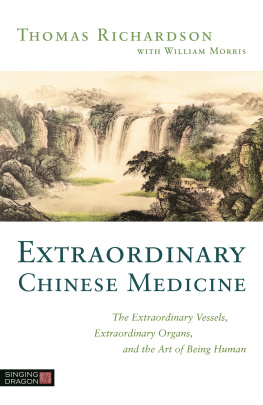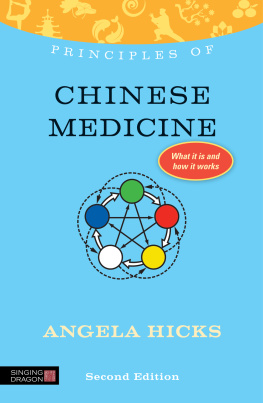
The Art and Practice of Diagnosis in
CHINESE MEDICINE

NIGEL CHING
Foreword by Jeremy Halpin

LONDON AND PHILADELPHIA
If a man will begin with certainties, he shall end in doubts; but if
he will be content to begin with doubts, he shall end in certainties.
Francis Bacon 15611626
CONTENTS
FOREWORD
Another way of seeing things
One of the most important contributions that Chinese medical diagnosis has given to the collective medical knowledge is the unique way it comprehends and describes conditions of disease. Chinese medicine does not use polarised belligerent metaphors that try to identify internal and external enemies that must be destroyed. Neither does it see the body as a dissociated and isolated island on which this war is waged. Chinese medicines focus is more on the constant adaptation to change.
To understand why this is so, it is necessary to understand the underlying medical model, or the logical principles that form the basis for this approach. To use a modern metaphor, the approach in this model focuses on software data flow and not hardware, i.e. on what is happening inside and not on the physical structure.
The model is energy based; it is not an anatomical/physiological model. It does not involve the study of dead bodies or the deconstruction of the body into ever smaller components in an attempt to describe the whole. Chinese medicine always sees everything in the context of the whole.
The Dao that can be named is not the Dao
The attentive reader will note that all the diagnostic models in this book describe the bodys response to change and not separate and arbitrary disease symptoms as such. This is because the state of balance in the body is in a state of constant flux and a skilled therapist will be able to track the signals that the body is emitting. In this context, to name something is to fossilise it. People are not their diabetes or migraine. They are unique individuals whose conscious and unconscious responses have brought them to this place. The art of diagnosis is to identify these unique patterns of response in each individual. In other words, it is the patient who is diagnosed and not the disease.
An exchange of stories
So what is diagnosis? In the late 1800s the meeting between the patient and practitioner was called an exchange of stories. This is where the patient presents their problem (story) as best they can, based on their subjective experiences. They can also present their story in more subtle and non-conscious ways, for example their posture, movement and other factors that can be observed by the clinician.
Diagnosis, which is the subject of this detailed book, forms the therapists story the therapists interpretation and response to the patients history through the filter of their knowledge and experience. It will include aspects such as observation, palpation and the use of other senses, such as the sense of smell or noting the way the persons shen is manifesting, to expand the practitioners perspective of the whole. All these factors are sorted in the diagnostic process through the various sub-models (the Eight Principles, Four Levels, Six Stages, etc.) to differentiate the possible diagnoses.
This does not, however, mean that the diagnosis ends here. For example, it is common to recheck the pulse diagnosis during the treatment to measure the response. In fact, treatment and diagnosis are never separated. They are constantly influencing each other and are two sides of the same coin.
When looking at new models such as this one, it is easy to drown in the volume of cultural references that permeate it. What Nigel Ching has achieved in this thorough and detailed study of traditional Chinese diagnosis is to outline and explain clearly both the methodology and, perhaps more importantly, the thinking behind it. It is especially this that I am convinced will prove to be indispensable to both students and interested readers.
Jeremy Halpin
Acupuncturist, Zen-shiatsu therapist and teacher
Stockholm, June 2008
PREFACE
An experienced Chinese medicine doctor can often diagnose a patient before the patient has even begun to tell the doctor what their disorder is. This may sound fantastic, as if the doctor has supernatural abilities, something that only a few people with special powers can do. This ability, though, depends on years of experience and a thorough understanding of the bodys physiology and pathology. The doctor will have consciously and subconsciously picked up on a myriad of small and sometimes extremely subtle signs, such as the expression in the patients eye, the facial complexion, the tone of the flesh, how the movement of the person is, how their posture is, the strength of their handshake and whether the hand feels clammy or dry, whether the hand is cold or hot and if it is warm whether it is the whole hand or only the palm that feels hot, how their attire is, the smell of their body, the sound of their voice, etc. All these individual small signs and signals will create an overall impression in the doctors mind, enabling the doctor to identify the patterns of imbalance that the patient is presenting with.
Charlie Buck once said that this ability which experienced Chinese doctors possess is the same ability that a good ornithologist possesses. If a novice like me is going to be able to identify a bird in my garden, the bird must stand still and I must also have sufficient time to take note of the size of the birds body, its wingspan, the colours in the plumage, the colour and length of the legs and beak, how it moves and so forth. Furthermore, I must then compare this information with the descriptions presented in an ornithology manual to see which bird it is that has precisely these colours and characteristics. However, an experienced ornithologist will immediately recognise which bird it is that is sitting on the bird table. An experienced ornithologist will not only recognise the bird when it sits on the bird table outside the window, but will also be able to identify the bird at a distance, even when it flies quickly past. Where others will barely have noticed the bird at all, just a few fleeting impressions will enable the experienced ornithologist to identify the bird with certainty. This ability is the result of many years of experience of studying the bird both through binoculars and with the naked eye, as well as having studied pictures and read descriptions of the bird in ornithological manuals. This will have resulted in an ability to recognise birds quickly from a minimum of signals.
This is also the case with an experienced Chinese medical doctor. The doctor will have gathered sufficient information before the patient talks of their problem to be reasonably certain of their diagnosis. The rest of the consultation is then used to confirm the diagnosis and to identify the aetiology and whether there are contributing patterns of imbalance.
This might give the impression that diagnosis goes from being analytical to being simply intuitive, but this is not so. Diagnostic intuition is nothing other than the rapid, subconscious analysis and interpretation of impressions and signals and relating these impressions to all the previous experiences of these signs. At the same time, these signs and impressions are subconsciously compared with the theoretical knowledge that has been gleaned from books and teachers. The subconscious is much quicker at analysing and sorting information than the conscious brain. Intuition is therefore not a supernatural ability but something that most of us are capable of. It just requires experience and a sound theoretical foundation.
Next page
